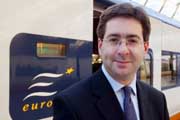Financial Outlook: What Does 2004 Hold for the Travel Sector?
2003 was a mixed year for the travel sector. Peaks and troughs brought both pleasure and pain to the sector. Ultimately, however, it was a tough and turbulent year only showing signs of improvement in the last quarter. As those in the business prepare for what is predicted to be a calmer and more triumphant year, Breaking Travel News caught up with some of the industries leading figures to discuss their views on how the year may unfold.
 Ian Coghlan, Managing Director, Abercrombie & Kent Ltd:
Ian Coghlan, Managing Director, Abercrombie & Kent Ltd:
“Given the number of major incidences that directly affected our industry in 2003, early indications such as early revenue growth, point to a strengthening in the market. Particularly, in the long-haul sector where there is an increased demand from customers seeking more life enriching or experiential travel, with emphasis not only on suntans but also on culture and soft adventure.
The booking pattern continues to change with over 50% of all bookings departing within 8 weeks of departure. These can be nervous times for tour operators but for those who can hold their nerve there are rich rewards in continued growth.
The move towards Internet bookings is there however these travel suppliers who, at best, give customers service only where necessary will not overly threaten those of us who provide service wherever possible.”
ADVERTISEMENT
 Paul Charles, Director of Communications, Eurostar:
Paul Charles, Director of Communications, Eurostar:
“Judging by the start to 2004, we are upbeat about the outlook for this year. We have seen a 20% increase in passenger numbers year-on-year and are expecting that trend to continue. With European economies picking up growth, it seems that business travellers are choosing to travel more often again. They realise that they may miss out on important contracts if they don’t sit face-to-face with potential clients.
On the leisure side, the biggest growth area seems to be in shortbreaks and daytrips because high-speed rail has made European inter-city travel so convenient. Travellers are choosing Eurostar above the airline competition because the city-centre to city-centre journey time is far quicker and the fares are often lower. So, we expect this year to be a record year for us, carrying in excess of 7 million people.”
 Anita Mehra Homayoun, Marketing and Corporate Communications Director, Dubai International Airport:
Anita Mehra Homayoun, Marketing and Corporate Communications Director, Dubai International Airport:
“Dubai International Airport is not just Middle East’s premier airport; it is counted among the top airports in the world today. It has been ranked as the second fastest growing airport in the world in 2002 according to Airports Council International (ACI).
In 2003, the airport witnessed a 13% growth and this positive outlook is expected to continue not just in 2004 but in the coming years as well. While in 2004 it is expected that over 20 million passengers will use the airport, according to projections, this figure is expected to reach 60 million by 2010.
This surge in passenger movement is consistent with the growth of Emirates airline. Dubai is investing US 20 billion dollars in the aviation industry as the outlook is extremely positive. Dubai International Airport is undergoing a US $ 4.1 billion dollar expansion, while Emirates has ordered aircraft worth US$ 15 billion.”
 Richard Adams, Senior Vice President EMEA, Sabre Travel Network:
Richard Adams, Senior Vice President EMEA, Sabre Travel Network:
We are already seeing a heartening recovery - barring any unforeseen circumstances this should be a better year than the past few.
 Scott Carson, President, Connexion by Boeing:
Scott Carson, President, Connexion by Boeing:
We remain cautiously optimistic that things will continue to improve in the airline industry and passenger numbers will be growing.
——-

